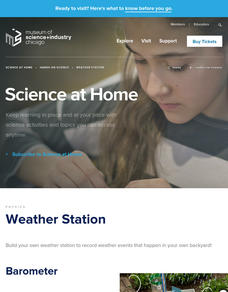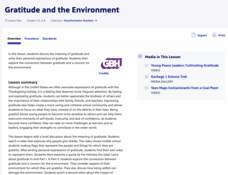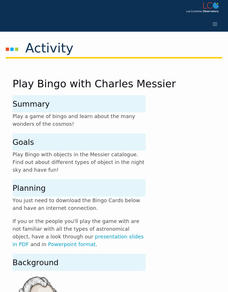Museum of Science
Create Gas
Let's have a gas. Individuals mix baking soda and vinegar in a bottle. Learners view the interaction between the solid and the liquid and notice that a gas is formed. Scholars notice the gas inflates a balloon stretched across the mouth...
Museum of Science
Worm Farm
It is not a barrel of monkeys—it's a jar of worms! Scholars create a worm farm in a spaghetti sauce jar. Pupils layer moist soil, sand, and oatmeal to create a habitat for worms. Individuals place worms into the habitat, cover it with...
Museum of Science
Wind Turbine
Let the energy blow. Using mostly easily found material such as PVC pipe and fans, pupils build wind turbines. Scholars connect a multimeter to an electric motor to determine the amount of energy generated by their designs. Learners then...
Museum of Science
Strawberry DNA
Humans aren't the only ones with DNA—fruit has it too. Using a extraction solution, pupils pull the DNA out of a piece of fruit. Learners crush up a piece of fruit with the solution and filter out the solids. Scholars then add cold...
Museum of Science
Cup Drop
Create egg drop soup. Teachers first set up eggs that are held up above cups of water with a piece of cardboard and cardboard tubes. Learners try to determine a way to get the eggs to drop into the cups. Using a broom, the instructor...
Museum of Science
Comeback Can
Convert energy within a can. Learners build a can that suspends a weight inside the can via a rubber band. The pupils roll the can away from them as the rubber band wraps around itself. The force of the band unwinding brings the can back...
Museum of Science
Candy Chromatography
Don't play favorites when separating candy colors. Pupils use the process of chromatography to separate the colors of two different types of candy-coated candies. Class members compare their results to an unknown sample to determine...
Museum of Science
Circuit Board
Light up the solutions. By following a set of directions, pupils build a circuit board with six different circuits. Learners use the circuit board to create a matching activity by connecting the questions to the correct answers via a...
Museum of Science
Weather Station
Find out what it is like outside before braving the elements. Teachers follow directions to build a barometer, rain gauge, and anemometer. Class members use the built weather instruments along with a thermometer to record weather...
Museum of Science
Water Balloon Catapult
Fire away! Using a couple of milk jugs, a dowel rod, and a yardstick, individuals build catapults to throw water balloons. Learners notice that the catapult is a simple machine. By making a target, the class has a chance to refine their...
Museum of Science
Straw Bridges
There is never a bridge too far. Using common items, class members build bridges to span an opening. Pupils test different geometric shapes to determine which is the strongest. Learners use pennies to find the strength of their bridges...
University of Waikato
Observing Water's Thin 'Skin'
Keep the tension up in the classroom. The class first observes as the teacher creates a dome of water above a glass by adding paperclips into an already full glass. Classmates then work in pairs to see how many drops of water can fit...
PBS
Gratitude and the Environment
A class discussion begins a two-part lesson plan about gratitude and the environment. In part one, learners watch a video then share their feelings about its most memorable moment. Delving deep into the meaning of gratitude, scholars...
NASA
Watering Your Plants
Make sure plants have water to drink regularly. Learners investigate the parts of a watering system for plants. They design and create a watering system for a lunar plant growth chamber before explaining why it is important to have water...
Las Cumbres Observatory
Return to Earth: Build a Lander
Earth to all instructors: Here's a resource to use about spacecraft. After learning about gravity and air resistance, scholars create landers with padding to help capsules land safely on Earth. They test their creations by placing a raw...
NASA
Exploring the Moon
Can plants grow on the moon? The second lesson plan in a five-part series has pupils explore the resources available on the moon to determine if plant life is possible. They use lava rocks as their soil and draw conclusions about the...
NASA
Natural Resources on Earth
Natural resources do not always occur so naturally. Lead classes through a thorough set of lessons investigating the natural resources important for plants. Learners complete a series of worksheets as they explore the information and...
Las Cumbres Observatory
Astronaut Training: Dexterity
How do astronauts do anything with those gloves on? Learners mimic what astronauts need to overcome as they complete puzzles while wearing multiple gloves. They time themselves and use the information to draw conclusions about the...
Las Cumbres Observatory
Astronaut Training: Taste
Gravity isn't the only thing astronauts lose in space. Learners investigate why astronauts complain about a loss of taste while in space in a hands-on activity. They taste test foods while limiting their other senses and rate each food...
Las Cumbres Observatory
Down2Earth: Making Impact Craters
Is the sky falling? Learners use a simulator to modify the mass and velocity of asteroids and collect data on how they influence the diameter and depth of the impact crater. They use their results to draw conclusions and make predictions...
Las Cumbres Observatory
Play Bingo with Charles Messier
Let's play an out-of-this-world Bingo game! Using pre-made Bingo cards and an online randomizer, host a game of Bingo to practice identifying the objects of the cosmos. Pupils must match a picture shown to a similar picture on their...
California Academy of Science
Modeling Eclipses with Size and Distance Scales
Size within the solar system is a difficult thing for pupils to imagine. Using everyday objects, they build models to show the scale between the sun, moon, and Earth. They situate their props in proportional distances between the objects...
California Academy of Science
Paper Cup Planetarium
Bring the night sky to your classroom! Using simple materials, learners create flashlight constellations on the wall. They then use their imaginations to create their own star patterns that tell a story.
NASA
Designing and Building the Lunar Plant Growth Chamber
Build a place for the plants. Using information learned from the previous lesson in the unit, learners design a lunar plant growth chamber and build a paper model of it. Given strips of paper that represent different sizes of planting...

























